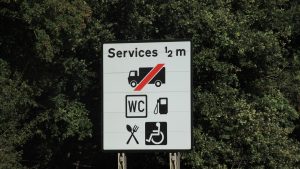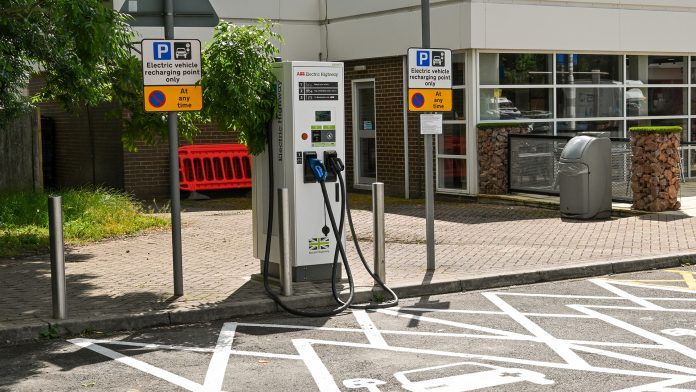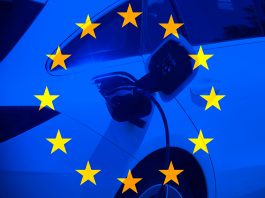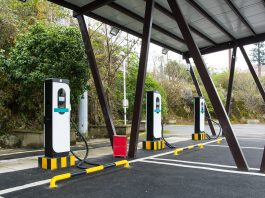Mark Winn, Head of EV Strategy at SMS Plc, explores the role of motorway service stations in building the UK’s public EV charging network.
As the EV industry drives forward its mission to accommodate the mass transition to low-carbon transport, it must continue to ensure that the correct EV charging infrastructure is deployed and installed – meeting the specific needs of the driver at that location.
As such, motorway service stations are crucial to the UK’s public EV charging network.
The simple fact is that an EV should be charged at a convenient spot when the driver would naturally take a break in a journey. Motorway and A-road service stations provide an accessible and convenient location for both consumer and commercial drivers to do just this.
Thanks to UK Government campaigns, drivers know that a rest or comfort break is vital when driving long distances. However, it now provides the perfect opportunity to recharge the vehicle and the human, ensuring enough power is available to reach the desired destination.
An added bonus is that they also emulate the ‘petrol and diesel refuelling’ experience they have come to expect, which helps to reduce the risk of range or charge anxiety.
Is the UK government really ‘taking charge’ through its EV infrastructure strategy?
To address this, the UK government made a pledge to install 6,000 ultra-rapid EV chargers on both motorways and A-roads across the country by 2035. However, in 2022, it promised that there would be six or more rapid or ultra-rapid chargers at motorway stations by the end of 2023.
In November last year, at COP28, the UK government announced that a further £70m will be invested into EV chargepoint offerings at motorway services.
Fast forward to the beginning of 2024, and an RAC study revealed that the government did not make good on its promise – a mere 39 per cent of motorway service stations now have 100kW and/or 150kW+ Ultra-Rapid chargers in place.
The RAC goes further to highlight that, in fact, only 581 have been installed on England’s motorways, which means that a further 714 are required to meet last year’s target alone. So what’s causing the holdup?
Motorway services need energy to power up
Access to public funding and private investment is always essential for any national infrastructure project. The same has been seen for the rollout of the UK’s full-fibre network.
However, there’s an additional challenge that the EV industry faces: ensuring that the energy is needed to power these 6,000 EV chargepoints.
This is no mean feat, in order to power the six ultra-rapid chargers per station requires approximately 900kW-1800kW of extra energy at each site. And to accommodate the 40-50 ultra-rapid chargers at each of its sites that Moto has committed to installing by 2023, the equivalent of a quarter of an average Nuclear Power Station output, or 150KwH+ per charge, will be required.

This significant amount of additional energy must be made available to every motorway and A-road service station by the end of 2035. That’s if the UK government is to make good on its original pledge.
Industry collaboration with the National Grid is essential
The energy is there to power the UK’s transition to EVs. Despite reports to the contrary, the National Grid has been changing the distribution of power within our energy system for a number of years, all in order to meet the changing needs and increasing demand on the UK’s energy consumption, beyond the change in the way transport is fuelled.
Over the past 15 years, the National Grid has been transitioning away from high carbon-intensive fuel sources, such as coal and gas, located centrally up and down the UK, where energy was distributed outwards. Instead, it has had a razor-sharp focus on an increase in usage of more renewable energy sources, including off-shore wind generation, bringing power inwards as it is funnelled throughout the country.
It’s almost as though it was planned. This change in the direction of the UK’s energy will help reduce the complexity of bringing power to both motorway and A-Road service stations. This is especially true of those that are located in the more rural areas. However, this process is not as simple as flicking a switch and turning on the electricity.
There will need to be increasing collaboration between the government, National Grid, the Distribution Network Operators (DNOs), and the wider EV charging infrastructure to ensure that motorway service stations have the right amount of power for the transition both now and in the future.
Changes to planning rules and reforms to the grid connection process will remove some of the biggest barriers to the rollout of electric vehicle (EV) chargepoints at motorway services.
The government has committed to looking at removing unnecessary planning constraints and accelerating the expansion of EV charging infrastructure, consulting on amending the National Planning Policy Framework to ensure the planning system prioritises the rollout of EV charge points and hubs.
Substantive action must also address the lengthy wait to secure power connections. Reforming the grid connection process will cut waiting times and free up over 100GW of capacity so that projects can connect sooner. This will enable most projects to get their requested connection and could reduce overall connection delays from five years to no more than six months.
There is no excuse for providing the public with substandard EV charging solutions. It’s time to give motorway and A-road service stations a major reboot with the energy they need to play their part in supporting the UK’s transition to electric.
Only then will the UK have the public EV charging infrastructure it needs and deserves.









